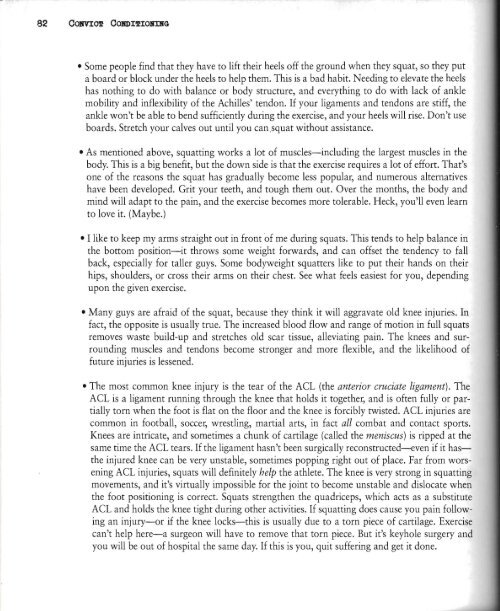Convict Conditioning - Paul Wade
Create successful ePaper yourself
Turn your PDF publications into a flip-book with our unique Google optimized e-Paper software.
82 COBVICT COBDITIOllIBG<br />
• Some people find that they have to lift their heels off the ground when they squat, so they put<br />
a board or block under the heels to help them. This is a bad habit. Needing to elevate the heels<br />
has nothing to do with balance or body structure, and everything to do with lack of ankle<br />
mobility and inflexibility of the Achilles' tendon. If your ligaments and tendons are stiff, the<br />
ankle won't be able to bend sufficiently during the exercise, and your heels will rise. Don't use<br />
boards. Stretch your calves out until you can .squat without assistance.<br />
• As mentioned above, squatting works a lot of muscles-including the largest muscles in the<br />
body. This is a big benefit, but the down side is that the exercise requires a lot of effort. That's<br />
one of the reasons the squat has gradually become less popular, and numerous alternatives<br />
have been developed. Grit your teeth, and tough them out. Over the months, the body and<br />
mind will adapt to the pain, and the exercise becomes more tolerable. Heck, you'll even learn<br />
to love it. (Maybe.)<br />
• I like to keep my arms straight out in front of me during squats. This tends to help balance in<br />
the bottom position-it throws some weight forwards, and can offset the tendency to fall<br />
back, especially for taller guys. Some bodyweight squatters like to put their hands on their<br />
hips, shoulders, or cross their arms on their chest. See what feels easiest for you, depending<br />
upon the given exercise.<br />
• Many guys are afraid of the squat, because they think it will aggravate old knee injuries. In<br />
fact, the opposite is usually true. The increased blood flow and range of motion in full squats<br />
removes waste build-up and stretches old scar tissue, alleviating pain. The knees and surrounding<br />
muscles and tendons become stronger and more flexible, and the likelihood of<br />
future injuries is lessened.<br />
• The most common knee injury is the tear of the ACL (the anterior cruciate ligament). The<br />
ACL is a ligament running through the knee that holds it together, and is often fully or partially<br />
torn when the foot is flat on the floor and the knee is forcibly twisted. ACL injuries are<br />
common in football, soccer, wrestling, martial arts, in fact all combat and contact sports.<br />
Knees are intricate, and sometimes a chunk of cartilage (called the meniscus) is ripped at the<br />
same time the ACL tears. Ifthe ligament hasn't been surgically reconstructed-even if it hasthe<br />
injured knee can be very unstable, sometimes popping right out of place. Far from worsening<br />
ACL injuries, squats will definitely help the athlete. The knee is very strong in squatting<br />
movements, and it's virtually impossible for the joint to become unstable and dislocate when<br />
the foot positioning is correct. Squats strengthen the quadriceps, which acts as a substitute<br />
ACL and holds the knee tight during other activities. Ifsquatting does cause you pain following<br />
an injury-or if the knee locks-this is usually due to a torn piece of cartilage. Exercise<br />
can't help here-a surgeon will have to remove that torn piece. But it's keyhole surgery and<br />
you will be out of hospital the same day. Ifthis is you, quit suffering and get it done.


